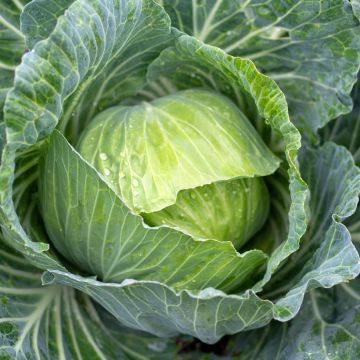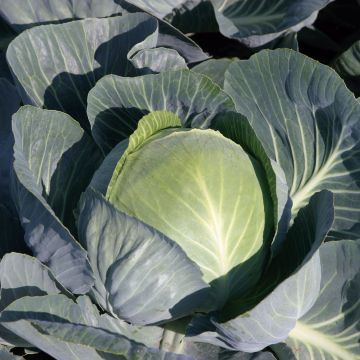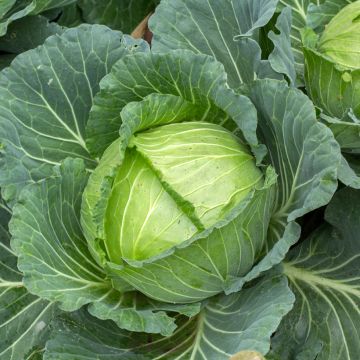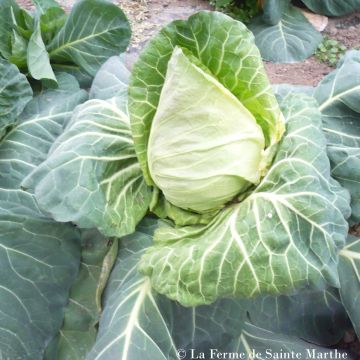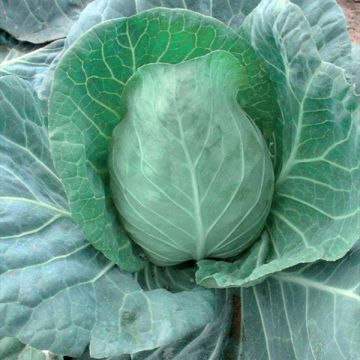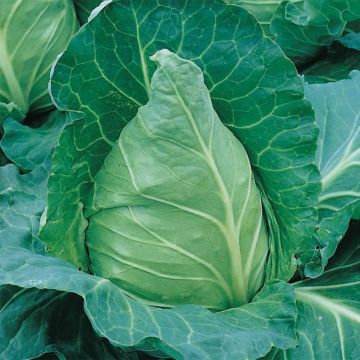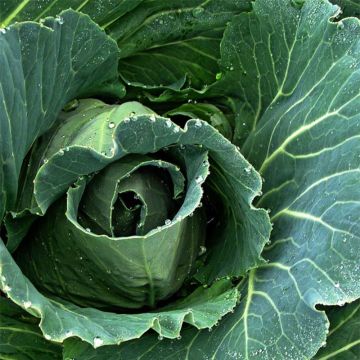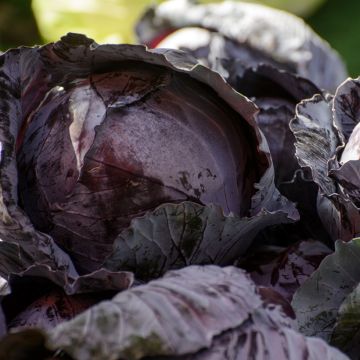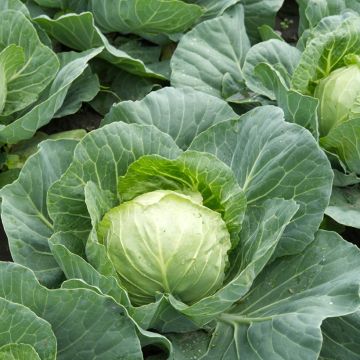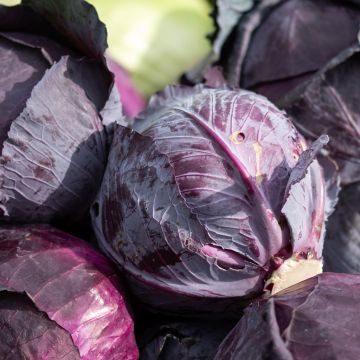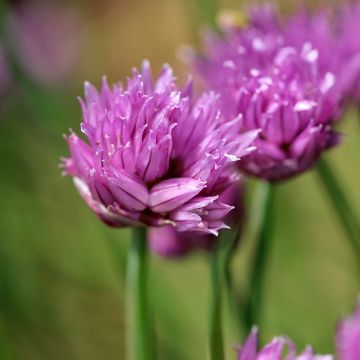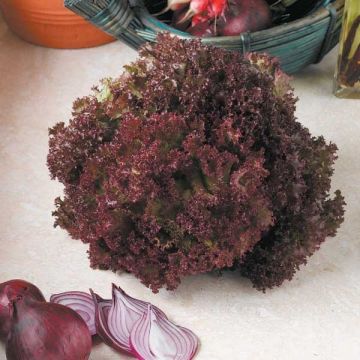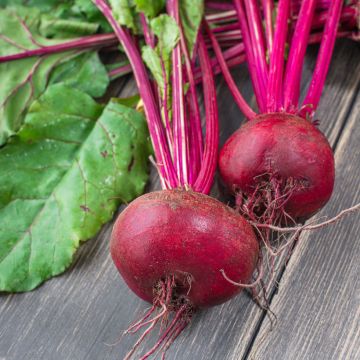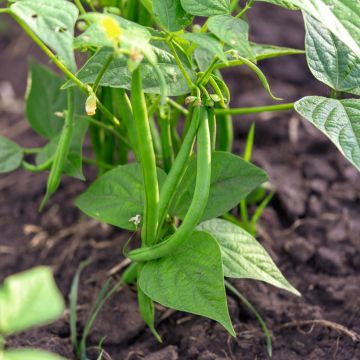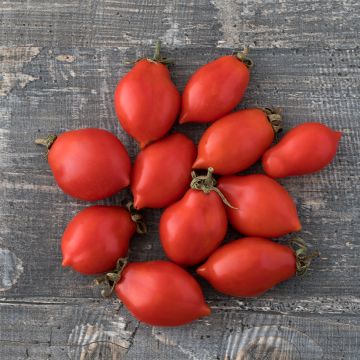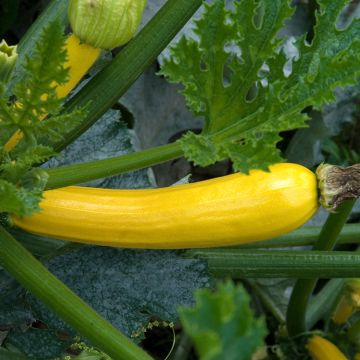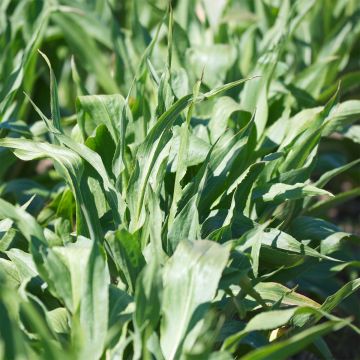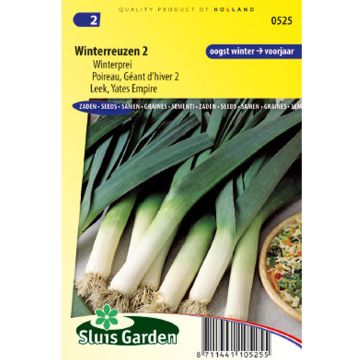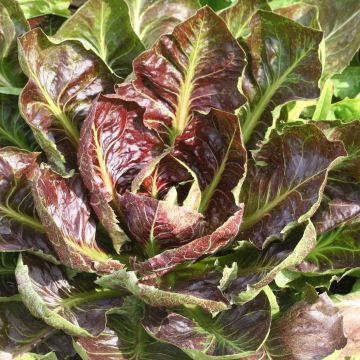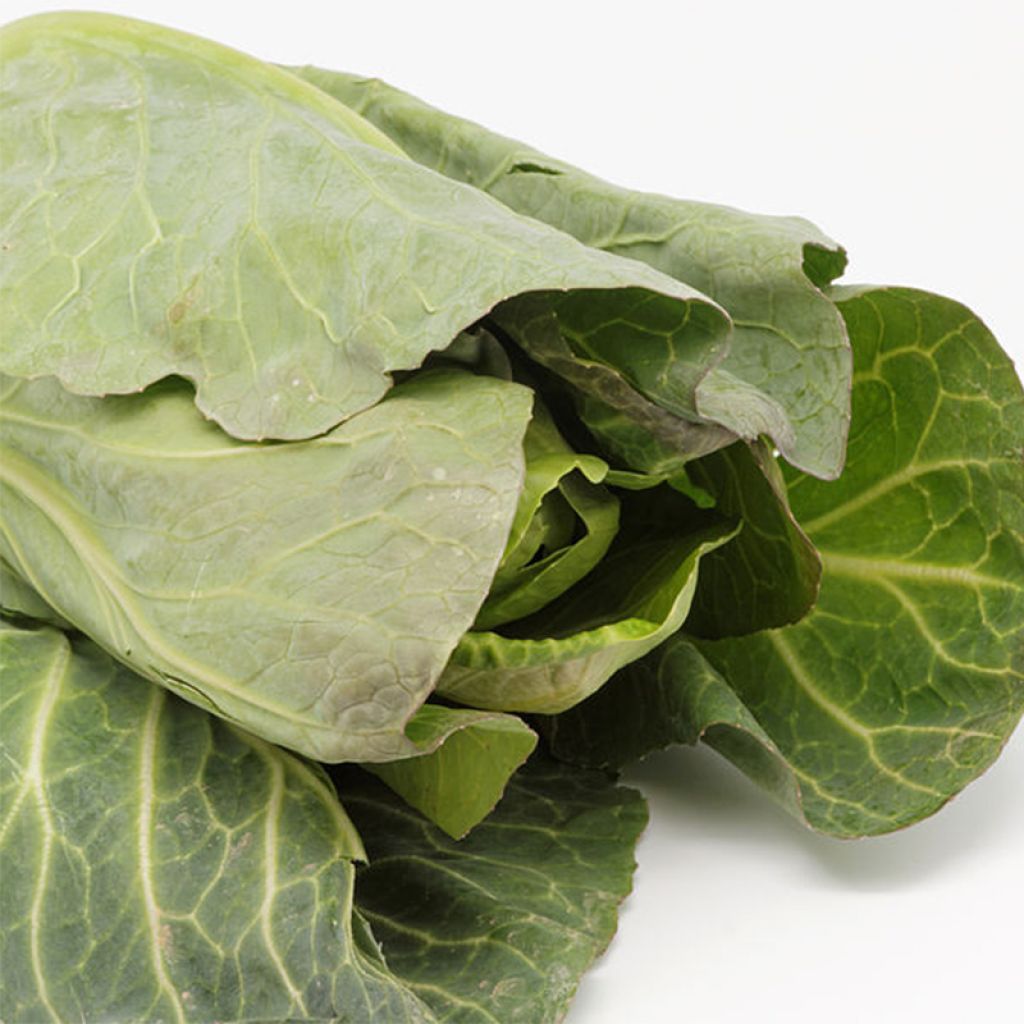

Organic Cabbage Pointu de Chateaurenard - Brassica oleracea capitata
Organic Cabbage Pointu de Chateaurenard - Brassica oleracea capitata
Brassica oleracea capitata Pointu de Chateaurenard
Cabbage
Looking forward to sowing them!
Frédérique J., 14/11/2018
This plant carries a 6 months recovery warranty
More information
We guarantee the quality of our plants for a full growing cycle, and will replace at our expense any plant that fails to recover under normal climatic and planting conditions.
Seed-only orders are dispatched by sealed envelope. The delivery charge for seed-only orders is €3.90.
Delivery to Corse prohibited: UE law prohibits the import of this plant from mainland France to Corse as part of the fight against Xylella fastidiosa. Please accept our sincere apologies.
More information

Description
The Pointed Cabbage of Chateaurenard is a typical variety from the Bouches du Rhone region, offering pointed heads, tightly packed, weighing between 700g and 1kg, with smooth blue-green leaves. It is an early cabbage with a mild flavour that can be eaten raw or cooked. It is resistant to running to seed and can be sown from mid-August to late September for a harvest from April to June.
The Round Cabbage or Cabbage is a very popular leaf vegetable. It is a must-have in the vegetable garden, and if we love it so much, it may be as much for its flavour as for the generous heads it forms.
Indifferently called Cabbage or Round Cabbage (in Latin Brassica oleracea capitata, capitata meaning "head"), this beautiful vegetable plant belongs to the large family of Brassicaceae (formerly Cruciferous). Originally from Europe, it is a biennial plant cultivated as an annual that produces a more or less tight head, which can be round, slightly flattened, or sharply conical in pointed varieties. The leaves of the Round Cabbage are smooth, and their colour varies depending on the varieties: from very light green, almost white, to dark green, sometimes slightly bluish, to red tinged with violet or nearly black.
Cabbage, although emblematic of winter, can be sown and harvested almost all year round. Varieties are generally grouped into three main categories: spring cabbages that are harvested from late April to June, summer and autumn cabbages for the period from July and winter cabbages that, along with leeks and parsnips, allow you to wait until the first spring harvests.
Round Cabbage can be eaten raw or cooked; it can be prepared, grated in salads, braised to accompany meat and fish dishes, stuffed or even used in soups and sauerkraut. There is no shortage of recipes, both in traditional and modern cuisine.
From a dietary point of view, it is remarkable: its energy value is low, but it is very rich in vitamins C, B6, and B9; it also contains a lot of fibre and minerals such as calcium.
In the vegetable garden, it is easy to grow as long as you meet its requirements: deep soil, excellent manure, and regular moisture. It thrives in the sun and generally does well in cool and rainy climates.
Harvest: it is done when the cabbage forms a nice head and before the leaves start to turn yellow. It is done with a knife by cutting just below the head.
Storage: round cabbage can be kept in the refrigerator for several days. It can also be frozen well after being blanched in salted boiling water. Winter varieties can also be left in the ground. Finally, the preparation of sauerkraut (lacto-fermentation) allows you to preserve autumn varieties with white heads deliciously.
The gardener's little trick: Don't forget the flowers! Even though the vegetable garden is primarily a garden for producing quality vegetables, it is always interesting to plant flowers. First and foremost, for the aesthetic pleasure they provide, but also to repel pests and attract valuable pollinators. So, don't hesitate to plant, in the middle of the rows or along the edges of the bed, Gaillardias, Marigolds, Zinnias, Cosmos, Nasturtiums, or even beautiful aromatic herbs like Dill. However, be careful with certain plants, although very useful, like Borage, which tends to self-seed abundantly in spaces dedicated to crops.
Report an error about the product description
Harvest
Plant habit
Foliage
Botanical data
Brassica
oleracea
capitata Pointu de Chateaurenard
Brassicaceae
Cabbage
Cultivar or hybrid
Annual
Other White Cabbage
Planting and care
Sowing:
The germination temperature of the Pointed Cabbage from Chateaurenard is around 15°C (59°F) (minimum 10°C (50°F), maximum 30°C (86°F)) and takes 5 to 14 days.
Sowing period: from mid-August to late September
Harvest period: from April to June
You can either sow directly in place or prepare seedlings that will later be planted in their final position in the garden.
Preparing seedlings: Under cover from late autumn to the end of winter or in a greenhouse in the garden for the rest of the year (depending on the recommended sowing period), sow the seeds at a depth of 1 to 2 cm (0 to 1in) in a good seed compost or fine soil. Lightly cover with compost, and keep the substrate moist but not soggy.
When the young plants appear strong enough to be handled, transplant them into pots if necessary before planting them in the garden when there is no longer any risk of frost. During planting, respect the recommended spacing for direct sowing.
Direct sowing: In suitably amended and finely worked soil, make furrows about one or two centimetres deep, spaced 50 centimetres (20 inches) apart. Sow the seeds and cover them with a thin layer of fine soil. When the seedlings are well developed, thin them out, leaving only one plant every 50 centimetres (20 inches).
Cultivation:
The Cabbage is grown in the sun. It is a demanding vegetable that requires well-rotted, nitrogen-rich, and potassium-rich soil. Applying a generous amount of mature compost (about 3/4 kg per m2) is preferable by scratching it into the soil to a depth of 5 cm (2in), preferably in autumn, after loosening the soil as is done for any vegetable cultivation. It is not very tolerant of soil pH, which should be between 5.6 and 6.5. In acidic soil, it will be necessary to gradually raise the pH by adding calcium in the form of dolomite or lime.
It is beneficial to associate it with many vegetables, such as tomatoes and lettuce. But avoid planting it near other Brassicas and zucchini, fennel, lamb's lettuce, leeks, and strawberries.
Beware of pests such as Cabbage White Butterflies or Flea Beetles, and consider using insect netting. Cabbage is generally quite susceptible to diseases such as Clubroot, so it is important to rotate crops in the plots.
Seedlings
Care
Intended location
-
, onOrder confirmed
Reply from on Promesse de fleurs
Vegetable seeds
Haven't found what you were looking for?
Hardiness is the lowest winter temperature a plant can endure without suffering serious damage or even dying. However, hardiness is affected by location (a sheltered area, such as a patio), protection (winter cover) and soil type (hardiness is improved by well-drained soil).

Photo Sharing Terms & Conditions
In order to encourage gardeners to interact and share their experiences, Promesse de fleurs offers various media enabling content to be uploaded onto its Site - in particular via the ‘Photo sharing’ module.
The User agrees to refrain from:
- Posting any content that is illegal, prejudicial, insulting, racist, inciteful to hatred, revisionist, contrary to public decency, that infringes on privacy or on the privacy rights of third parties, in particular the publicity rights of persons and goods, intellectual property rights, or the right to privacy.
- Submitting content on behalf of a third party;
- Impersonate the identity of a third party and/or publish any personal information about a third party;
In general, the User undertakes to refrain from any unethical behaviour.
All Content (in particular text, comments, files, images, photos, videos, creative works, etc.), which may be subject to property or intellectual property rights, image or other private rights, shall remain the property of the User, subject to the limited rights granted by the terms of the licence granted by Promesse de fleurs as stated below. Users are at liberty to publish or not to publish such Content on the Site, notably via the ‘Photo Sharing’ facility, and accept that this Content shall be made public and freely accessible, notably on the Internet.
Users further acknowledge, undertake to have ,and guarantee that they hold all necessary rights and permissions to publish such material on the Site, in particular with regard to the legislation in force pertaining to any privacy, property, intellectual property, image, or contractual rights, or rights of any other nature. By publishing such Content on the Site, Users acknowledge accepting full liability as publishers of the Content within the meaning of the law, and grant Promesse de fleurs, free of charge, an inclusive, worldwide licence for the said Content for the entire duration of its publication, including all reproduction, representation, up/downloading, displaying, performing, transmission, and storage rights.
Users also grant permission for their name to be linked to the Content and accept that this link may not always be made available.
By engaging in posting material, Users consent to their Content becoming automatically accessible on the Internet, in particular on other sites and/or blogs and/or web pages of the Promesse de fleurs site, including in particular social pages and the Promesse de fleurs catalogue.
Users may secure the removal of entrusted content free of charge by issuing a simple request via our contact form.
The flowering period indicated on our website applies to countries and regions located in USDA zone 8 (France, the United Kingdom, Ireland, the Netherlands, etc.)
It will vary according to where you live:
- In zones 9 to 10 (Italy, Spain, Greece, etc.), flowering will occur about 2 to 4 weeks earlier.
- In zones 6 to 7 (Germany, Poland, Slovenia, and lower mountainous regions), flowering will be delayed by 2 to 3 weeks.
- In zone 5 (Central Europe, Scandinavia), blooming will be delayed by 3 to 5 weeks.
In temperate climates, pruning of spring-flowering shrubs (forsythia, spireas, etc.) should be done just after flowering.
Pruning of summer-flowering shrubs (Indian Lilac, Perovskia, etc.) can be done in winter or spring.
In cold regions as well as with frost-sensitive plants, avoid pruning too early when severe frosts may still occur.
The planting period indicated on our website applies to countries and regions located in USDA zone 8 (France, United Kingdom, Ireland, Netherlands).
It will vary according to where you live:
- In Mediterranean zones (Marseille, Madrid, Milan, etc.), autumn and winter are the best planting periods.
- In continental zones (Strasbourg, Munich, Vienna, etc.), delay planting by 2 to 3 weeks in spring and bring it forward by 2 to 4 weeks in autumn.
- In mountainous regions (the Alps, Pyrenees, Carpathians, etc.), it is best to plant in late spring (May-June) or late summer (August-September).
The harvesting period indicated on our website applies to countries and regions in USDA zone 8 (France, England, Ireland, the Netherlands).
In colder areas (Scandinavia, Poland, Austria...) fruit and vegetable harvests are likely to be delayed by 3-4 weeks.
In warmer areas (Italy, Spain, Greece, etc.), harvesting will probably take place earlier, depending on weather conditions.
The sowing periods indicated on our website apply to countries and regions within USDA Zone 8 (France, UK, Ireland, Netherlands).
In colder areas (Scandinavia, Poland, Austria...), delay any outdoor sowing by 3-4 weeks, or sow under glass.
In warmer climes (Italy, Spain, Greece, etc.), bring outdoor sowing forward by a few weeks.

































